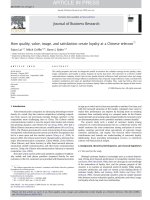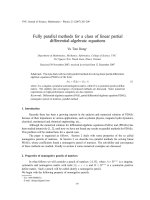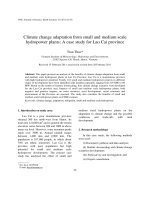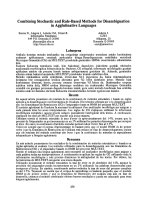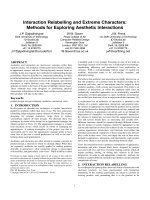IMAGE PROCESSING AND SUPER RESOLUTION METHODS FOR A LINEAR 3D RANGE IMAGE SCANNING DEVICE FOR FORENSIC IMAGING
Bạn đang xem bản rút gọn của tài liệu. Xem và tải ngay bản đầy đủ của tài liệu tại đây (1.18 MB, 59 trang )
Graduate School ETD Form 9
(Revised 12/07)
PURDUE UNIVERSITY
GRADUATE SCHOOL
Thesis/Dissertation Acceptance
This is to certify that the thesis/dissertation prepared
By
Entitled
For the degree of
Is approved by the final examining committee:
Chair
To the best of my knowledge and as understood by the student in the Research Integrity and
Copyright Disclaimer (Graduate School Form 20), this thesis/dissertation adheres to the provisions of
Purdue University’s “Policy on Integrity in Research” and the use of copyrighted material.
Approved by Major Professor(s): ____________________________________
____________________________________
Approved by:
Head of the Graduate Program Date
Abhishek Shriram Joshi
Image Processing and Super Resolution Methods for a Linear 3D Range Image Scanning
Device for Forensic Imaging
Master of Science
Mihran Tuceryan
Shiaofen Fang
Jiang Yu Zheng
Mihran Tuceryan
Shiaofen Fang
05/24/2012
Graduate School Form 20
(Revised 9/10)
PURDUE UNIVERSITY
GRADUATE SCHOOL
Research Integrity and Copyright Disclaimer
Title of Thesis/Dissertation:
For the degree of
Choose your degree
I certify that in the preparation of this thesis, I have observed the provisions of Purdue University
Executive Memorandum No. C-22, September 6, 1991, Policy on Integrity in Research.*
Further, I certify that this work is free of plagiarism and all materials appearing in this
thesis/dissertation have been properly quoted and attributed.
I certify that all copyrighted material incorporated into this thesis/dissertation is in compliance with the
United States’ copyright law and that I have received written permission from the copyright owners for
my use of their work, which is beyond the scope of the law. I agree to indemnify and save harmless
Purdue University from any and all claims that may be asserted or that may arise from any copyright
violation.
______________________________________
Printed Name and Signature of Candidate
______________________________________
Date (month/day/year)
*Located at />Image Processing and Super Resolution Methods for a Linear 3D Range Image Scanning
Device for Forensic Imaging
Master of Science
Abhishek Shriram Joshi
05/24/2012
IMAGE PROCESSING AND SUPER RESOLUTION METHODS FOR A LINEAR 3D
RANGE IMAGE SCANNING DEVICE FOR FORENSIC IMAGING
A Thesis
Submitted to the Faculty
of
Purdue University
by
Abhishek Shriram Joshi
In Partial Fulfillment of the
Requirements for the Degree
of
Master of Science
August 2012
Purdue University
Indianapolis, Indiana
ii
ACKNOWLEDGMENTS
I would like to express my deep and sincere gratitude to my advisor, Dr. Mihran
Tuceryan for his guidance and encouragement throughout my Thesis and Graduate
studies. Dr. Tuceryan was very helpful and supportive during the entire process.
I also want to thank Dr. Shiaofen Fang and Dr. Jiang Zheng for agreeing to be a part of
my Thesis Committee.
Thank you to all my friends and well-wishers for their good wishes and support. And
most importantly, I would like to thank my family for their unconditional love and
support.
iii
TABLE OF CONTENTS
Page
LIST OF TABLES v
LIST OF FIGURES vi
ABSTRACT viii
CHAPTER 1: INTRODUCTION 1
CHAPTER 2: BACKGROUND 3
2.1 Frequency Domain 7
2.2 Spatial Domain Methods 8
2.2.1 Interpolation of Non-Uniformly Spaced Samples 9
2.2.2 Iterated Backprojection 9
2.2.3 Stochastic SR Reconstruction Methods 10
2.2.4 Set Theoretic Reconstruction Methods 11
2.2.5 Optimal and Adaptive Filtering 12
2.3 Comparison Between Frequency Domain and Spatial Domain
SR Reconstructions 13
CHAPTER 3: METHODOLOGY 14
3.1 Imaging Device 14
iv
Page
3.2 Laser Detection 16
3.2.1 Peak Based Detection 16
3.2.2 Edge Based Laser Detection 19
3.3 Super Resolution 20
3.3.1 Data Pre-Processing 21
3.3.2 Least Squares Formulation 22
3.3.3 Error Minimization 26
CHAPTER 4: EXPERIMENTAL RESULTS 34
CHAPTER 5: CONCLUSION 42
5.1 Summary 43
5.2 Discussion 44
5.3 Future Work 44
LIST OF REFERENCES 45
v
LIST OF TABLES
Table Page
Table 1 Frequency Domain vs. Spatial Domain SR 13
Table 2 Sub-Pixel overlap based on Speed and Distance from Camera 28
vi
LIST OF FIGURES
Figure Page
Figure 1 Basics of Super Resolution 5
Figure 2 Image Acquisition System 6
Figure 3 Linear Actuator used to collect data 15
Figure 4 Imaging System 16
Figure 5 Color based laser stripe detection steps 17
Figure 6 Correction for Image Roll 21
Figure 7 HR Geometric Transformation 24
Figure 8 Image Registration Model 26
Figure 9 Generating Profile of Video 27
Figure 10 Profile of a video with distance from camera = 20.5’ and speed = 1 27
Figure 11 Profile of a video with distance from camera = 20.5’ and
speed = 3 (Right), speed = 4 (Left) 29
Figure 12 Error Function minimization for Additive Noise with
Standard Deviation = 0. 35
Figure 13 Error Function minimization for Additive Noise with
Standard Deviation = 1 36
vii
Figure Page
Figure 14 Error Function minimization for Additive Noise with
Standard Deviation = 4 37
Figure 15 (a) Original LR image (b) Initial Estimate based on 3 LR frames
and noise with Standard Deviation = 1 (c) Reconstructed SR image. 38
Figure 16 (a) Original LR image (b) Initial Estimate based on 3 LR frames
and noise with Standard Deviation = 4 (c) Reconstructed SR image 38
Figure 17 (a) Original LR image (b) Initial Estimate based on 2 LR frames
and noise with Standard Deviation = 1 (c) Reconstructed SR image 39
Figure 18 (a) Original LR image (b) Initial Estimate based on 2 LR frames
and noise with Standard Deviation = 4 (c) Reconstructed SR image 39
Figure 19 Low resolution (1080*650 pixels) input image 40
Figure 20 Zoomed in low resolution (Top) and High Resolution Image (Bottom) 40
Figure 21 High Resolution Image 3240*650 pixels 40
Figure 22 High Resolution Image 2160*650 pixels 41
Figure 23 Low resolution (1080*650 pixels) input image 41
Figure 24 Zoomed in low resolution (Top) and High Resolution Image (Bottom) 41
Figure 25 Low resolution (1080*800 pixels) input image 42
Figure 26 Zoomed in low resolution (Top) and High Resolution Image (Bottom) 42
Figure 27 High Resolution Image 2160*800 pixels 42
viii
ABSTRACT
Joshi, Abhishek Shriram. M.S., Purdue University, August, 2012. Image Processing and
Super Resolution Methods for a Linear 3D Range Image Scanning Device for Forensic
Imaging. Major Professor: Mihran Tuceryan.
In the last few decades, forensic science has played a significant role in bringing
criminals to justice. Shoe and tire track impressions found at the crime scene are
important pieces of evidence since the marks and cracks on them can be uniquely tied to
a person or vehicle respectively. We have designed a device that can generate a highly
accurate 3-Dimensional (3D) map of an impression without disturbing the evidence. The
device uses lasers to detect the changes in depth and hence it is crucial to accurately
detect the position of the laser.
Typically, the forensic applications require very high resolution images in order to be
useful in prosecutions of criminals. Limitations of the hardware technology have led to
the use of signal and image processing methods to achieve high resolution images. Super
Resolution is the process of generating higher resolution images from multiple low
resolution images using knowledge about the motion and the properties of the imaging
geometry. This thesis presents methods for developing some of the image processing
components of the 3D impression scanning device. In particular, the thesis describes the
following two components: (i) methods to detect the laser stripes projected onto the
ix
impression surface in order to calculate the deformations of the laser stripes due to 3D
surface shape being scanned, and (ii) methods to improve the resolution of the digitized
color image of the impression by utilizing multiple overlapping low resolution images
captured during the scanning process and super resolution techniques.
1
CHAPTER 1: INTRODUCTION
In a wide variety of imaging applications it is crucial to capture the fine details in the
image. The use of forensic imaging is one such application domain where the fine details
in either color two-dimensional (2D) images or the fine details of three-dimensional (3D)
depth images of evidence recovered in crime scenes may result in successful prosecution
and conviction of criminals. Sometimes the success of such prosecutions depends on the
existence of individualizing characteristics of the evidence that can be very small
[1][2][3]. The ability to capture these fine details is related to the resolution of the image
being captured.
In this thesis we describe the components of a 3D imaging device which is designed for
capturing foot print and tire track impressions in crime scenes. The device works by
detecting a laser stripe in an image captured by a video camera and moving this
laser/camera assembly in a linear motion to generate the full 3D depth image as well as a
2D color texture image. The highly accurate detection and localization of the laser stripe
enhances the resolution and accuracy of the depth image. The use of super resolution
imaging techniques improves the accuracy and resolution of the captured 2D texture
image.
2
Super Resolution is a vast topic encompassing many aspects of image processing. The
particular contributions of this thesis to this topic are the following:
The development of the image processing techniques for accurately detecting the
laser stripe in the captured video frame images. We investigated two methods to
accurately detect the position of the laser
o Peak based detection
o Edge based detection
The development of a super-resolution technique which utilizes the linear motion
model of the scanning device in order to improve the resolution of the captured 2D
color texture image.
Chapter 2 gives a brief background and reviews the relevant prior research. Chapter 3
presents a brief description of the device, the methodology for laser stripe detection, and
the methodology of obtaining super-resolution color texture images. Chapter 4 presents
experimental results. Finally, Chapter 5 makes concluding remarks and suggests some
future work.
3
CHAPTER 2: BACKGROUND
The resolution of a 2D image is affected by a number of factors such as the density of the
sensing elements on the sensor array, the resolving power of the optical pathway, and the
motion of the objects in the scene or the motion of the camera. Since 1970’s, charge-
coupled device (CCD) and CMOS image sensors have been widely used to capture
digital images. These sensors are suitable for most imaging applications, but the current
resolution and cost may not be sufficient for certain applications that require the ability to
capture minute details [4]. Scientists or criminalists often need digital high resolution
images, with no visible artifacts when the image is magnified, similar to 35mm analog
film.
A direct solution to the problem is to reduce pixel size and increase pixel density by
sensor manufacturing techniques. However, reducing the pixel size decreases the amount
of light available to each of the pixels. This leads to shot noise that severely degrades the
quality of the image. It is estimated that pixel size cannot be reduced beyond 40 µm
2
for a
0.35 µm CMOS process [4]. The current image sensor technology has almost reached this
level. Another possible solution to achieve higher spatial resolution is to increase the size
of the chip. However, increasing the size of the chip leads to an increase in capacitance.
One promising approach to improve resolution is using signal and image processing
4
techniques to obtain a higher resolution image from multiple lower resolution images.
This is called Super-resolution (SR) and is a process of estimating a single high
resolution image or video from a given set of low resolution inputs obtained from slightly
shifted viewpoints. The major advantage of using signal processing to achieve high
resolution is its cost effectiveness because existing low resolution imaging systems can
still be utilized. SR image reconstruction is very effective in applications where multiple
frames of the same scene can be obtained, and the motion is to obtain such images is not
very big or is very constrained.
In super resolution, the lower resolution images represent different looks of the same
scene. The technique relies on the fact that if the motion of the camera is sufficiently
constrained and there is overlap in the pixels of the images of different views of the
scene, this overlapped information can be used to recover sub-pixel level image
information to compute a higher resolution image. Thus, the low resolution images are
subsampled and shifted with sub-pixel precision. Multiple scenes can be obtained from
one camera with several captures or from multiple cameras located in different positions.
The scene motions can be obtained using controlled motion in imaging systems, e.g.,
video sequence obtained from a camera mounted on a linear actuator. If the low
resolution images are shifted by integer multiples of pixel units, no new information can
be obtained to reconstruct the high resolution image because there would be no overlap
between pixels of the low resolution images.
5
Figure 1 Basics of Super Resolution
During the process of recording a digital image, there is inherent loss of spatial resolution
due to optical distortions (out of focus, diffraction limit, etc.), motion blur due to limited
shutter speed, noise that occurs within the sensor or during transmission, and insufficient
sensor density as shown in Figure 2. Super resolution also covers image restoration
techniques that produce high quality images from noisy and blurred images.
6
Figure 2 Image Acquisition System
Super Resolution reconstruction is an example of an ill-posed inverse problem [6] as a
number of possible solutions exist for a given set of observed images. A common model
for SR is stated in the following way: The low resolution input images are the result of
projection of a high resolution image onto the image plane, followed by sampling. The
main goal is to find the high resolution image which best fits this model given the
observed low resolutions images. In the literature, there seems to be two broad
approached to Super Resolution image reconstruction:
Frequency Domain Methods
Spatial Domain Methods
7
2.1 Frequency Domain
A large number of super resolution algorithms operate in the frequency domain. They are
based on 3 fundamental principles [2]:
Fourier Transform’s shifting properties relating spatial domain translations and
frequency domain properties.
Aliasing relationship between the continuous Fourier transforms (CFT) and the
discrete Fourier Transform (DFT).
The original scene being band limited.
These properties can be used to formulate a set of equations relating the aliased DFT
coefficients of the observed low resolution images to sample of the CFT of the unknown
scene. By solving this set of equations we can get frequency domain coefficients of the
original scene. We can now recover the original scene by computing the inverse DFT. In
order to accurately formulate the set of equations it is necessary to have knowledge of the
translation motion between frames to sub-pixel accuracy. Restrictions have to be placed
on the inter-frame motion that contributes useful data since each low resolution image
must have equations independent of each other.
The shifting property of the CFT relates spatial domain translation to the frequency
domain as phase shifting given by
,
∆
∆
, …Eq (1)
8
If , is band limited, then ∃
,
such that, → 0 for
|
|
and
|
|
. If we assume that , is band limited, we can rewrite the aliasing
relationship in the matrix form as,
…Eq (2)
Y is an 1 column vector with the r
th
element being the DFT coefficients
,
of
the observed image
,
. relates the DFT of observed data samples of the
unknown CFT of , contained in the 4
1 vector F.
Frequency domain super resolution methods have the advantage of being theoretically
simple and computationally easy. They are also well suited for parallel computation as
the equations of one observed image are independent of others. One major disadvantage
is the limitation imposed by the assumption of a global translation motion model and the
space invariant degradation models. It also has limited ability for inclusion of knowledge
of spatial domain properties for regularization.
2.2 Spatial Domain Methods
In this class of methods, spatial domain properties are used to formulate the image
formation and motion model in order to reconstruct the higher resolution image. The
spatial domain observation model accommodates global and non-global motion, optical
blur, motion blur, spatially varying point spread function (PSF), non-ideal sampling, and
compression artifacts. Spatial domain reconstruction allows inclusion of a-priori
constraints.
9
Let be the SR image reconstructed from low resolution images
,∈,, ,
and
are related by the following equation.
incorporates motion compensation, degradation effects and subsampling.
2.2.1 Interpolation of Non-Uniformly Spaced Samples
Motion compensation is used to register a set of low resolution images into a single,
dense composite image of non-uniformly spaced samples. This dense composite image is
then used to reconstruct a super resolved image using techniques for reconstruction from
non-uniformly spaced samples. Degradation can be compensated by applying image
restoration techniques. Iterative reconstruction techniques, based in the Landweber
iteration have been used [3]. This method is overly simplistic; it cannot reconstruct
significantly more content than present in a single low resolution image. Degradation
models are limited, and no a priori constraints are used.
2.2.2 Iterated Backprojection
Given a SR estimate and the imaging model H, it is possible to simulate the low
resolution images as . Iterated backprojection (IBP) procedures update the
estimate of the SR reconstruction by minimizing the back projection error between the j
th
simulated low resolution image
and the observed Y via the back projection operator
H
BP
.
10
2.2.3 Stochastic SR Reconstruction Methods
In this method the SR reconstruction is treated as a statistical estimation problem. They
have gained prominence due to their ability to provide a framework for the inclusion of a
priori constrains necessary for satisfactory solution of the ill-posed SR inverse problem.
The observed data Y, noise N and SR image X are assumed stochastic. Consider the
following equation:
The Maximum A Posteriori (MAP) approach for estimating X seeks to estimate
for
which the a-posteriori probability Pr
|
is a maximum. Formally,
is
calculated
using the following equation.
argmax
Pr
|
argmax
logPr
|
logPr
…Eq (3)
This is achieved by applying Bayes’ rule, since,
is independent of and
taking logarithms. log| is a log likelihood function and is the density of
X. The likelihood function is determined by the PDF of the noise as
|
. Markov Random Field image is used to model the prior term.
Maximum likelihood (ML) estimation has also been used for SR reconstruction [2]. It is a
special case of MAP estimation (no prior term). Since prior term is crucial for solving the
ill posed inverse problem, MAP estimation should be used instead of ML.
11
2.2.4 Set Theoretic Reconstruction Methods
Set theoretic methods are popular as they are simple and utilize powerful spatial domain
observation model. Methods of projection onto convex sets (POCS) are especially
popular as they allow convenient inclusion of information. In set theoretic methods, the
space of ST solution images is intersected with a set of constraint sets representing
desirable SR image characteristics. These characteristics include properties such as
positivity, bounded energy, fidelity of data, smoothness etc., to yield a reduced solution
space. POCS refers to an iterative procedure which, given any point in the space SR
images, locates a point which satisfies all the convex constrains sets.
Convex sets representing constraints on solution space X are defined.
Data inconsistency is represented by a set :
|
|
Positivity by ∶
0∀
Bounded Energy by ∶
|
|
Compact support ∶
0,∈
A projection operator is also determined for each convex constraint. The projection
∝
associated with constraint set
∝
projects a point in the space of z onto the closest point
on the surface of
∝
. It is possible to converge to a solution on the surface of the
intersection of the K convex constraints sets by iterative application,
…
. This point is however not guaranteed to be unique since it is
dependent on the initial guess.
12
An alternate SR reconstruction method uses ellipsoid to bind the constraint set [5]. The
centroid of this ellipse is taken as the SR estimate. An iterative method is used to find a
solution since direct computation is infeasible.
The main disadvantage of using Set Theoretic SR reconstruction is the non-uniqueness of
the solution. The solution is highly dependent on the initial guess. Also the convergence
rate for this method is very slow and has a high computational cost associated with it.
The bounded ellipsoid method ensures a unique solution. However, it cannot be assured
to be an optimal solution.
2.2.5 Optimal and Adaptive Filtering
A number of approaches towards SR reconstruction have been proposed using inverse
filtering. These techniques have limited ability to include a-priori constraints compared to
the powerful framework provided by Bayesian methods or POCS [4]. Some methods
have also been used in applications. These methods are in effect LMMSE estimators and
do not include non-linear a-priori constraints [2].
13
2.3 Comparison Between Frequency Domain and Spatial Domain SR Reconstructions
A general comparison of frequency and spatial domain SR reconstructions methods is
presented in [2]. We have presented that in Table 1.
Table 1 Frequency Domain vs. Spatial Domain SR
Frequency Domain Spatial Domain
Observation model Frequency domain Spatial domain
Motion models Global translation Almost unlimited
Degradation model Limited, LSI LSI or LSV
Noise model Limited, LSI Flexible
SR Mechanism De-aliasing De-aliasing A-priori info
Computation requirements Low High
A-priori info Limited No limit
Regularization Limited Excellent
Extensibility Poor Excellent
Applicability Limited Wide
Application performance Good Good
From the Table 1 above, it is evident that spatial domain based SR reconstruction
methods are better than frequency domain methods. Even though spatial domain based
methods are complex and computationally intensive, they provide a degree of flexibility
not provided by frequency domain methods.
14
CHAPTER 3: METHODOLOGY
This Chapter will describe the methods we used in order to solve the disparity image
computation and the SR image estimation using the a priori knowledge about the design
of our scanner. First, in Section 3.1 we briefly describe the relevant details of the
scanning device. Then in Section 3.2 we describe the details of detecting the laser stripes
in the captured video frames and thus computing the deformations in it due to the surface
shape being scanned. In Section 3.3 we describe our approach to improving the resolution
of the color texture image along the scan direction.
3.1 Imaging Device
The imaging device consists of a linear actuator and a high definition (HD) camera, and
two line lasers. The camera is mounted on a under carriage which is driven along the
length of the actuator by a stepper motor. The imaging geometry of the digitizing device
and an image of the prototype are shown in Figures 3 and 4. The speed of the stepper
motor can be precisely controlled and remains constant during the entire scan. A 1:10
gearbox translates the stepper motors power to the linear actuator. This ensures the
smooth motion of the carriage with extremely minimal variations in its speed.
